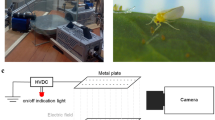The effects of weak electromagnetic irradiation on simple forms of behavior were studied using adult Tenebrio molitor mealworms. The beetles’ motor behavior was studied in conditions of different motivations, i.e., positive (food) and negative (avoidance of light), in otherwise identical experimental conditions. The beetles had to navigate a defined space to reach their target – potato or cover from light. Experiments consisted of one trial per day for five days. Target attainment time was measured in groups of beetles. Behavior in both cases developed as follows: an initial orientation reaction appeared and was followed by adaptation to the apparatus. Exposure to weak electromagnetic irradiation led to increases in the response time at the initial stages of the experiments. The effects of irradiation were seasonal in nature and differed in the two types of behavior.
Similar content being viewed by others
References
E. E. Burlakova, A. A. Konradov, and E. L. Maltseva, “Superweak interactions of chemical and physical factors in biological systems,” Biofizika, 49, 551–564 (2004).
E. K. Eskov, “Destabilization of cardiac function in an insect by a low-frequency electric field,” Biofizika, 51, 53–55 (2006).
N. D. Kreshchenko, I. M. Sheiman, and E. E. Fesenko, “Effects of weak electromagnetic radiation on cell regeneration in the planarian Dugesia tigrina,” Ontogenez, 32, 148–153 (2001).
Yu. A. Kholodov, Responses of the Nervous System to Electromagnetic Fields [in Russian], Nauka, Moscow (1975).
Yu. A. Kholodov, “Nonspecific responses of the nervous system to non-ionizing radiation,” Radiats. Biol. Radioékologiya, 38, 121–125 (1996).
I. M. Sheiman and E. E. Fesenko, “Effects of weak electromagnetic irradiation on morphogenesis in planarians,” Biofizika, 44, 1073–1077 (1999).
I. M. Sheiman and M. F. Shkutin, “Effects of weak electromagnetic irradiation on metamorphosis in the mealworm Tenebrio molitor,” Biofizika, 48, 111–116 (2003).
I. M. Sheiman and M. F. Shkutin, “Effects of weak electromagnetic irradiation on learning in the mealworm Tenebrio molitor,” Zh. Vyssh. Nerv. Deyat., 53, 775–780 (2003).
W. Engelmann,W. Hellrung, and A. Johnsson, “Circadian locomotor activity of Musca flies: recording method and effects of 10 Hz squarewave electric fields,” Bioelectromegnetics, 17, 100–110 (1996).
B. Greenberg, V. P. Vindokas, and J. R. Gauger, “Biological effects of a 765-kV transmission line: exposures and thresholds in honeybee colonies,” Bioelectromegnetics, 2, 315–328 (1981).
N. Pan and X. Liu, “Apparent biological effect of strong magnetic field on mosquito eggs hatching,” Bioelectromegnetics, 25, 84–91 (2004).
V. Peric-Mataruga, Z. Prolic, V. Nenadovic, M. Vlahovic, and M. Mrdacovic, “The effect of a static magnetic field on the morphometric characteristics of neurosecretory neurons and corpora allata in the pupae of yellow mealworm Tenebrio molitor (Tenebrionidae),” Int. J. Radiat. Biol., 84, 91–98 (2008).
D. Todorovic, A. Kalauzi, Z. Prolic, N. Jovic, and D. Mutavdizic, “A method for detecting the effect of magnetic field on activity changes of neuronal populations of Morimus funereus (Coleoptera, Carambycidae),” Bioelectromegnetics, 28, 238–241 (2007).
M. M. Walker and M. E. Bitterman, “Conditioned responding to magnetic fields by honeybees,” J. Comp. Physiol., 157, 67–76 (1985).
Author information
Authors and Affiliations
Corresponding author
Additional information
Translated from Zhurnal Vysshei Nervnoi Deyatel’nosti imeni I. P. Pavlova, Vol. 59, No. 4, pp. 488–494, July–August, 2009.
Rights and permissions
About this article
Cite this article
Sheiman, I.M., Kreshchenko, N.D. Effects of Weak Electromagnetic Irradiation on Various Types of Behavior in the Mealworm Tenebrio Molitor . Neurosci Behav Physi 40, 863–868 (2010). https://doi.org/10.1007/s11055-010-9335-z
Received:
Accepted:
Published:
Issue Date:
DOI: https://doi.org/10.1007/s11055-010-9335-z




